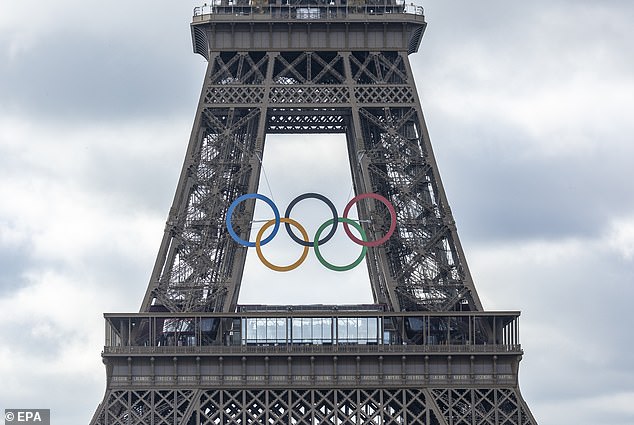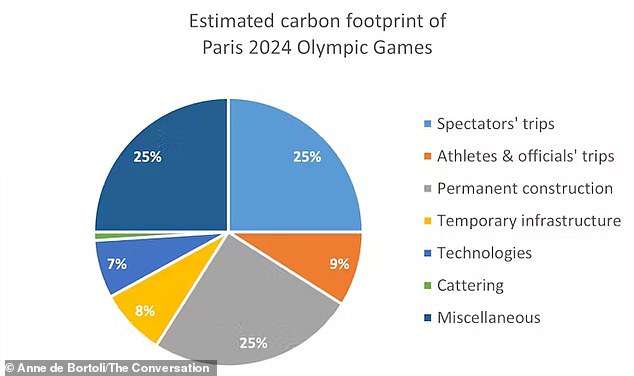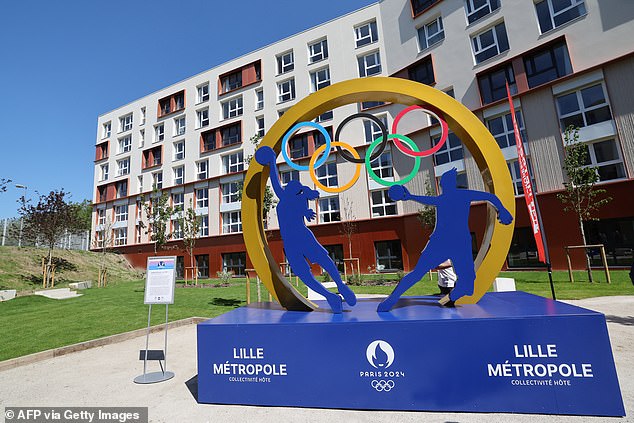Visiting the Olympics? Scientist calculates the carbon footprint of every visitor to Paris – and says it’s the equivalent of eating 31 hamburgers or drinking 83 bottles of wine
If you’re attending the Olympic Games in Paris in the coming weeks, be warned: your carbon footprint will increase dramatically.
Each visitor to the Olympic Games is responsible for 100kg of CO2 emissions, a scientist has revealed.
That’s the same as eating 31 hamburgers, drinking 83 bottles of wine, traveling 500 kilometers by car or 9,900 kilometers on the London Underground.
The academic warns that CO2 emissions during the Games will come from transportation, food, energy generation, construction and more.
The aim of Paris 2024 was to become the first Olympic Games to be completely carbon neutral, but this plan was quietly abandoned early in the planning stages.
Scientists have estimated the carbon footprint of each Olympic visitor – 100kg of CO2. That’s the equivalent of eating 31 hamburgers, or drinking 83 bottles of wine, or travelling 310 miles by car, or travelling 6,200 miles on the subway.

Pictured, at La Concorde Skate Park, ahead of the Paris Olympics, which begin on Friday (July 26).
Dr Anne de Bortoli, a climate scientist at the Polytechnique Montréal in Canada, believes CO2 emissions during the 2024 Paris Olympics will be higher than during Tokyo 2021, when spectators were forced to keep their distance due to Covid-19.
“It’s time to reinvent the Olympics and mega-events to align them with international climate goals,” she said in a piece for The conversation.
‘Some argue that their size is incompatible with sustainability and that they primarily serve the financial interests and pleasure of the elite.’
The carbon footprint is typically expressed in ‘CO2 equivalent’, a unit of measurement used to standardize the effects of greenhouse gases.
According to Dr. de Bortoli, the maximum carbon budget for Paris 2024 has been set at 1.58 million tonnes of CO2 equivalent (Mt CO2 eq).
In other words, emissions from the 2024 Paris Olympics must not exceed this amount if the Olympic organizers want to do their part to prevent a climate disaster.
“This is undoubtedly an ambitious target, especially when we consider that the Tokyo 2020 Olympic Games, organised during a pandemic and without spectators, will still emit almost 2 Mt of CO2,” said Dr de Bortoli.

It is seen as the greenest edition of the Olympic Games, but the exact carbon footprint of Paris 2024 will only be known after the Games have ended

Carbon emissions during the Olympic Games – or any other major event – come from a variety of sources, including transportation, new buildings and infrastructure, or even the production of meat slaughtered for consumption.
The exact carbon footprint of Paris 2024 will only be known after the Games have ended.
However, the academic estimates emissions at 1.6 Mt CO2-eq for 13 to 16 million visitors, or around 100 to 125 kg CO2-eq per person.
This is equivalent to the emissions from driving 500 kilometers by car, 10,000 kilometers by metro, eating 31 hamburgers or drinking 83 bottles of wine.
Carbon emissions during the Olympics – or any other major event – come from a variety of sources, including transportation, new buildings and infrastructure, and even the production of meat that is slaughtered for consumption.
The Olympic Committee has therefore decided to make this the ‘greenest edition ever’ and the first to be compatible with the Paris climate agreement.
Plans to drastically reduce greenhouse gas emissions during this year’s Games include limiting the construction of new buildings and using more environmentally friendly materials, such as wood and recycled local materials, in new construction.
The Olympic athletes’ “anti-sex beds” are made of cardboard and competitors are being fed more plant-based foods than ever before.

At the Olympic Village in Paris, ‘anti-sex beds’ for Olympians have been made from cardboard as part of an initiative to use more environmentally friendly materials

Because meat has the highest carbon footprint of all foods, the focus of the dishes served to the participants of Paris 2024 will be on vegetables and other plant-based alternatives. Pictured here is Thomas Bach (foreground), president of the International Olympic Committee, tasting the salad bar in the Olympic Village on Monday
And Paris 2024 aims to run entirely on renewable energy, including through solar cells, geothermal systems and biofuel generators.
It is hoped that emissions will at least be lower than those of Rio 2016 or London 2012 – both of which are “among the least environmentally friendly in history”.
Both events recorded approximately 3.5 Mt CO2 eq, which is equivalent to eating over a billion hamburgers.
The Olympic Committee promises that the actual carbon footprint will be published in the autumn, after the Games.
Dr. de Bortoli hopes the figure will be verified by an independent third party to ensure it is a reliable and accurate estimate.

The Olympic Village on the northern outskirts of Paris (pictured) will welcome 14,500 athletes during the Olympic Games and 9,000 athletes during the Paralympic Games
“The aim is to communicate the carbon footprint calculation in a transparent and reproducible manner,” she said.
More generally, the academic urges measures to limit global warming and comply with the Paris Climate Agreement.
Currently, the average annual carbon footprint of a European is around 7,800 kg CO2-eq. However, this needs to be ‘drastically’ reduced to 2,000.
“It would be fair if rich countries, which are responsible for the vast majority of emissions, took on the bulk of emission reductions,” she adds.
